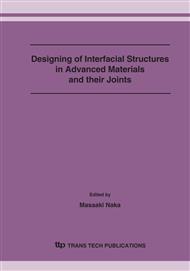p.3
p.9
p.15
p.19
p.25
p.31
p.37
p.43
p.51
Interface Development in Joining Yttria Stabilized Zirconia to Stainless Steel by In Situ Alloying with Ni/Ti Filler Metals
Abstract:
There is need for efficient energy conversion systems based on domestic fossil or biofuels. Solid Oxide Fuel Cells (SOFC's) are attractive in this case, however sealing is a critical issue in SOFC development. The purpose of this investigation is to find a procedure to seal yttria stabilized zirconia (YSZ) electrolyte to the stainless steel electrical interconnect or gas manifold. The seal is usually exposed to high temperatures in the range of 500 to 1000°C. Brazing by in-situ alloying of nickel and titanium foils was performed to braze zirconia to 444- stainless steel. Different combinations of nickel/titanium foils were used; brazing was done in vacuum at 6 x 10-6 torr at 960°C, 1010, and 1030°C for different brazing times. The braze and interfacial microstructures were characterized by optical microscopy, scanning electron microscopy (SEM), and energy dispersive spectroscopy (EDS). This paper assesses the effect of process parameters on the development and stability of the braze metal and the interactions of the filler metal with the two substrates.
Info:
Periodical:
Pages:
19-24
Citation:
Online since:
September 2007
Authors:
Price:
Сopyright:
© 2007 Trans Tech Publications Ltd. All Rights Reserved
Share:
Citation:


